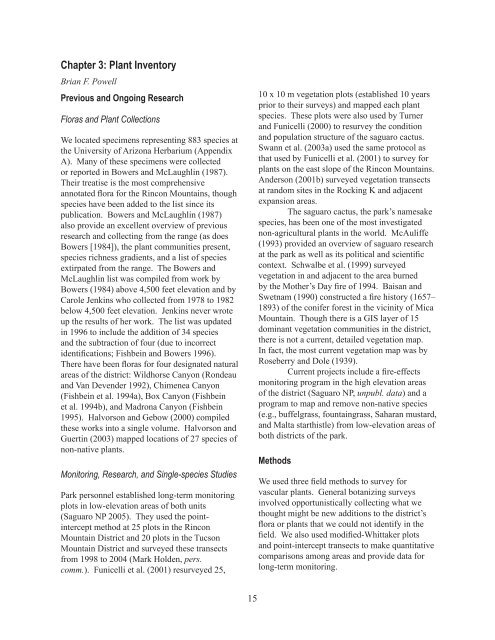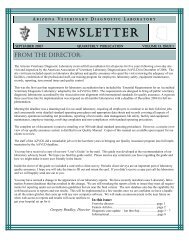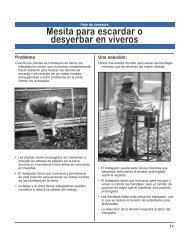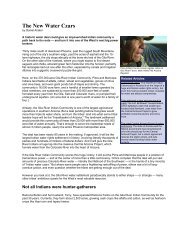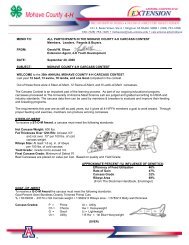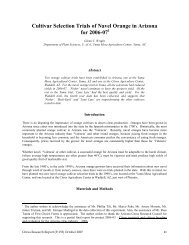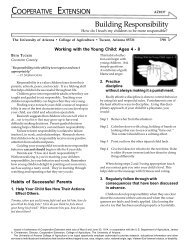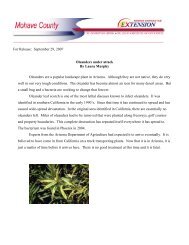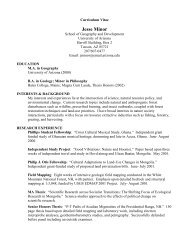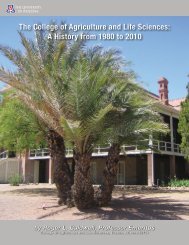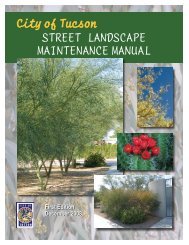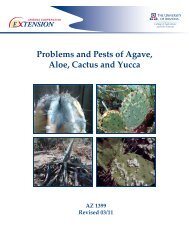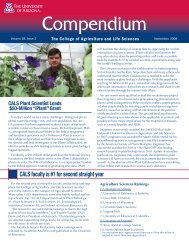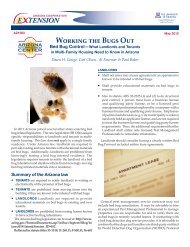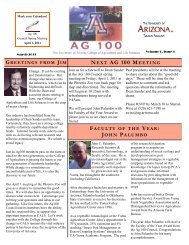Details - CALS Networking Lab - University of Arizona
Details - CALS Networking Lab - University of Arizona
Details - CALS Networking Lab - University of Arizona
Create successful ePaper yourself
Turn your PDF publications into a flip-book with our unique Google optimized e-Paper software.
Chapter 3: Plant Inventory<br />
Brian F. Powell<br />
Previous and Ongoing Research<br />
Floras and Plant Collections<br />
We located specimens representing 883 species at<br />
the <strong>University</strong> <strong>of</strong> <strong>Arizona</strong> Herbarium (Appendix<br />
A). Many <strong>of</strong> these specimens were collected<br />
or reported in Bowers and McLaughlin (1987).<br />
Their treatise is the most comprehensive<br />
annotated flora for the Rincon Mountains, though<br />
species have been added to the list since its<br />
publication. Bowers and McLaughlin (1987)<br />
also provide an excellent overview <strong>of</strong> previous<br />
research and collecting from the range (as does<br />
Bowers [1984]), the plant communities present,<br />
species richness gradients, and a list <strong>of</strong> species<br />
extirpated from the range. The Bowers and<br />
McLaughlin list was compiled from work by<br />
Bowers (1984) above 4,500 feet elevation and by<br />
Carole Jenkins who collected from 1978 to 1982<br />
below 4,500 feet elevation. Jenkins never wrote<br />
up the results <strong>of</strong> her work. The list was updated<br />
in 1996 to include the addition <strong>of</strong> 34 species<br />
and the subtraction <strong>of</strong> four (due to incorrect<br />
identifications; Fishbein and Bowers 1996).<br />
There have been floras for four designated natural<br />
areas <strong>of</strong> the district: Wildhorse Canyon (Rondeau<br />
and Van Devender 1992), Chimenea Canyon<br />
(Fishbein et al. 1994a), Box Canyon (Fishbein<br />
et al. 1994b), and Madrona Canyon (Fishbein<br />
1995). Halvorson and Gebow (2000) compiled<br />
these works into a single volume. Halvorson and<br />
Guertin (2003) mapped locations <strong>of</strong> 27 species <strong>of</strong><br />
non-native plants.<br />
Monitoring, Research, and Single-species Studies<br />
Park personnel established long-term monitoring<br />
plots in low-elevation areas <strong>of</strong> both units<br />
(Saguaro NP 2005). They used the pointintercept<br />
method at 25 plots in the Rincon<br />
Mountain District and 20 plots in the Tucson<br />
Mountain District and surveyed these transects<br />
from 1998 to 2004 (Mark Holden, pers.<br />
comm.). Funicelli et al. (2001) resurveyed 25,<br />
15<br />
10 x 10 m vegetation plots (established 10 years<br />
prior to their surveys) and mapped each plant<br />
species. These plots were also used by Turner<br />
and Funicelli (2000) to resurvey the condition<br />
and population structure <strong>of</strong> the saguaro cactus.<br />
Swann et al. (2003a) used the same protocol as<br />
that used by Funicelli et al. (2001) to survey for<br />
plants on the east slope <strong>of</strong> the Rincon Mountains.<br />
Anderson (2001b) surveyed vegetation transects<br />
at random sites in the Rocking K and adjacent<br />
expansion areas.<br />
The saguaro cactus, the park’s namesake<br />
species, has been one <strong>of</strong> the most investigated<br />
non-agricultural plants in the world. McAuliffe<br />
(1993) provided an overview <strong>of</strong> saguaro research<br />
at the park as well as its political and scientific<br />
context. Schwalbe et al. (1999) surveyed<br />
vegetation in and adjacent to the area burned<br />
by the Mother’s Day fire <strong>of</strong> 1994. Baisan and<br />
Swetnam (1990) constructed a fire history (1657–<br />
1893) <strong>of</strong> the conifer forest in the vicinity <strong>of</strong> Mica<br />
Mountain. Though there is a GIS layer <strong>of</strong> 15<br />
dominant vegetation communities in the district,<br />
there is not a current, detailed vegetation map.<br />
In fact, the most current vegetation map was by<br />
Roseberry and Dole (1939).<br />
Current projects include a fire-effects<br />
monitoring program in the high elevation areas<br />
<strong>of</strong> the district (Saguaro NP, unpubl. data) and a<br />
program to map and remove non-native species<br />
(e.g., buffelgrass, fountaingrass, Saharan mustard,<br />
and Malta starthistle) from low-elevation areas <strong>of</strong><br />
both districts <strong>of</strong> the park.<br />
Methods<br />
We used three field methods to survey for<br />
vascular plants. General botanizing surveys<br />
involved opportunistically collecting what we<br />
thought might be new additions to the district’s<br />
flora or plants that we could not identify in the<br />
field. We also used modified-Whittaker plots<br />
and point-intercept transects to make quantitative<br />
comparisons among areas and provide data for<br />
long-term monitoring.


